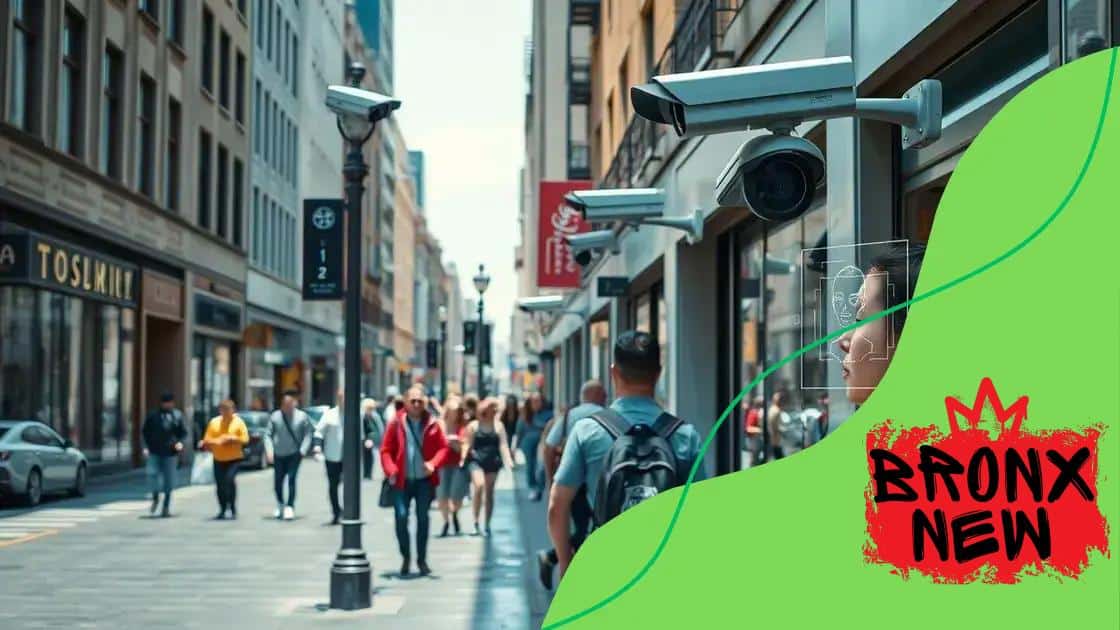The role of facial recognition in enhancing public safety

The role of facial recognition in enhancing public safety includes improving security during events, aiding law enforcement in suspect identification, and enabling efficient monitoring of public spaces while raising important privacy concerns.
Have you ever wondered how the role of facial recognition in enhancing public safety can impact your daily life? This technology is increasingly becoming a vital tool for law enforcement and civic safety. In this article, we’ll delve into how it works and what it means for our communities.
Understanding facial recognition technology
Understanding facial recognition technology is crucial in today’s digital world. This technology allows computers to identify and verify individuals by analyzing facial features.
How Facial Recognition Works
Facial recognition relies on complex algorithms. These algorithms assess various points on a person’s face and compare them to stored images. Here are some key elements of this process:
- Image Capture: This is where the technology scans and captures an image of a face.
- Feature Extraction: The software identifies important facial features.
- Matching: The algorithm compares the captured image with existing images in a database.
This process is fast and efficient, making it a valuable tool for security systems. The applications range from unlocking mobile devices to assisting law enforcement.
Applications in Public Safety
Facial recognition technology has various applications that enhance public safety. For example, it helps in identifying criminals in real-time. Furthermore, it can monitor public areas, ensuring a safer environment for everyone.
While the benefits are significant, it is essential to balance the use of this technology with privacy concerns. Discussions about regulations are ongoing to ensure that facial recognition is used responsibly, prioritizing safety without compromising personal privacy.
Understanding this technology is vital for navigating its impact on society. As we continue to adopt advanced security measures, facial recognition remains at the forefront, shaping how we perceive safety in public spaces.
Benefits of facial recognition in public spaces
The benefits of facial recognition in public spaces are numerous and increasingly important in today’s society. This technology can significantly enhance security measures, making environments safer for everyone.
Improved Security
Facial recognition technology enables law enforcement to identify suspects quickly. Detecting individuals in real-time helps prevent crime before it occurs. Additionally, it supports the investigation process following incidents.
- Immediate Identification: Officers can access databases instantly.
- Crime Prevention: Deterrence through visible surveillance.
- Dispute Resolution: Provides evidence in investigations.
Moreover, the technology can be invaluable in large events, such as concerts and sporting events. It helps monitor crowds and identify potential threats efficiently.
Enhanced Efficiency
Besides security, facial recognition increases operational efficiency. Public agencies can streamline access control to restricted areas, enabling authorized personnel to enter without delay. This reduces waiting times and improves overall user experience.
Another significant advantage is the ability to analyze visitor patterns in specific locations. When businesses and city planners understand how people move, they can create better, safer public spaces that enhance community engagement.
While the benefits are compelling, it’s essential to balance these advantages with privacy concerns. As communities adopt facial recognition, establishing guidelines to ensure responsible use will be crucial.
Privacy concerns with facial recognition

Privacy concerns with facial recognition are crucial as this technology becomes more widespread. Many people worry about how their personal information is being used and stored.
Data Collection and Storage
One major issue revolves around how data is collected and maintained. Facial recognition systems capture images of individuals in public spaces. This raises questions about consent and whether people know they are being watched.
- Surveillance Risks: Constant monitoring can feel invasive.
- Data Breaches: If security measures fail, personal data can be exposed.
- Unauthorized Use: Images might be used for purposes not originally intended.
These concerns highlight the need for robust policies to protect individuals’ privacy and ensure the responsible use of facial recognition technology.
Potential for Misuse
Another significant concern is the potential for misuse by governments and private companies. There is a fear that authorities might exploit facial recognition for unlawful tracking or profiling.
Moreover, biases in the technology can lead to innocent individuals being wrongly identified or targeted. This often affects marginalized communities disproportionately, raising ethical questions that society must address.
Having clear regulations is essential to mitigate these risks. Ongoing discussions are necessary to develop frameworks that prioritize privacy while allowing for the benefits of facial recognition in public safety.
Real-world examples of effective usage
Real-world examples of effective usage of facial recognition technology illustrate its potential benefits across various sectors. Cities worldwide have adopted this technology to enhance public safety.
Surveillance in Public Spaces
For instance, cities like London use facial recognition to monitor crowded events. This helps identify potential threats quickly, allowing law enforcement to respond efficiently.
- Increased Safety: Public areas become less risky due to proactive monitoring.
- Event Security: Crowds at concerts and festivals can be managed more effectively.
- Real-time Alerts: Authorities can be notified instantly about suspects.
Such implementations have proven valuable during large gatherings, where safety concerns are paramount.
Enhancing Law Enforcement
Another key application of facial recognition is in law enforcement. In the United States, police departments have successfully used this technology to solve crimes. By analyzing images from surveillance cameras, they can identify suspects.
The technology has helped recover stolen vehicles and locate missing persons. When agencies share data and collaborate, facial recognition becomes an even more potent tool.
While the technology has clear benefits, it is also crucial to ensure that its usage respects privacy rights. Balancing security and individual privacy remains a vital discussion as more cities and agencies adopt these systems.
The future of facial recognition in security
The future of facial recognition in security holds exciting possibilities. As technology advances, it is expected to become more accurate and widespread in various applications.
Advancements in Technology
New algorithms and machine learning techniques are being developed to improve the reliability of facial recognition systems. These advancements can lead to:
- Higher Accuracy: Reducing false positives and enhancing the identification process.
- Real-time Analysis: Allowing security personnel to respond to threats immediately.
- Integration with Other Technologies: Facial recognition could work alongside AI and big data to provide comprehensive security solutions.
These improvements will help security teams operate more efficiently and effectively.
Wider Adoption Across Sectors
As trust grows in this technology, more sectors are likely to adopt it for various purposes. Beyond law enforcement, businesses may use facial recognition for customer service enhancements. Retail stores might implement it to offer personalized shopping experiences to customers.
Event venues can utilize this technology to streamline entry processes, ensuring a smooth and safe experience for guests. As the technology also finds its way into homes, personal security systems may benefit from facial recognition features to enhance safety.
However, along with this growth comes the need for discussions around ethical use and regulations. It is vital to ensure that the implementation of facial recognition technology respects individual privacy and civil liberties. Balancing innovation with responsibility will shape the future landscape of security.
FAQ – Frequently Asked Questions about Facial Recognition Technology
What is facial recognition technology?
Facial recognition technology is a system that identifies or verifies a person by analyzing their facial features from images or video.
How can facial recognition enhance public safety?
By allowing law enforcement to quickly identify suspects and monitor public spaces, enhancing security during events.
Are there privacy concerns with using facial recognition?
Yes, there are significant privacy concerns, including unauthorized monitoring and risks of data misuse.
What are the future trends of facial recognition technology?
The future trends include improved accuracy, wider adoption in various sectors, and ongoing discussions about ethical use and regulations.





